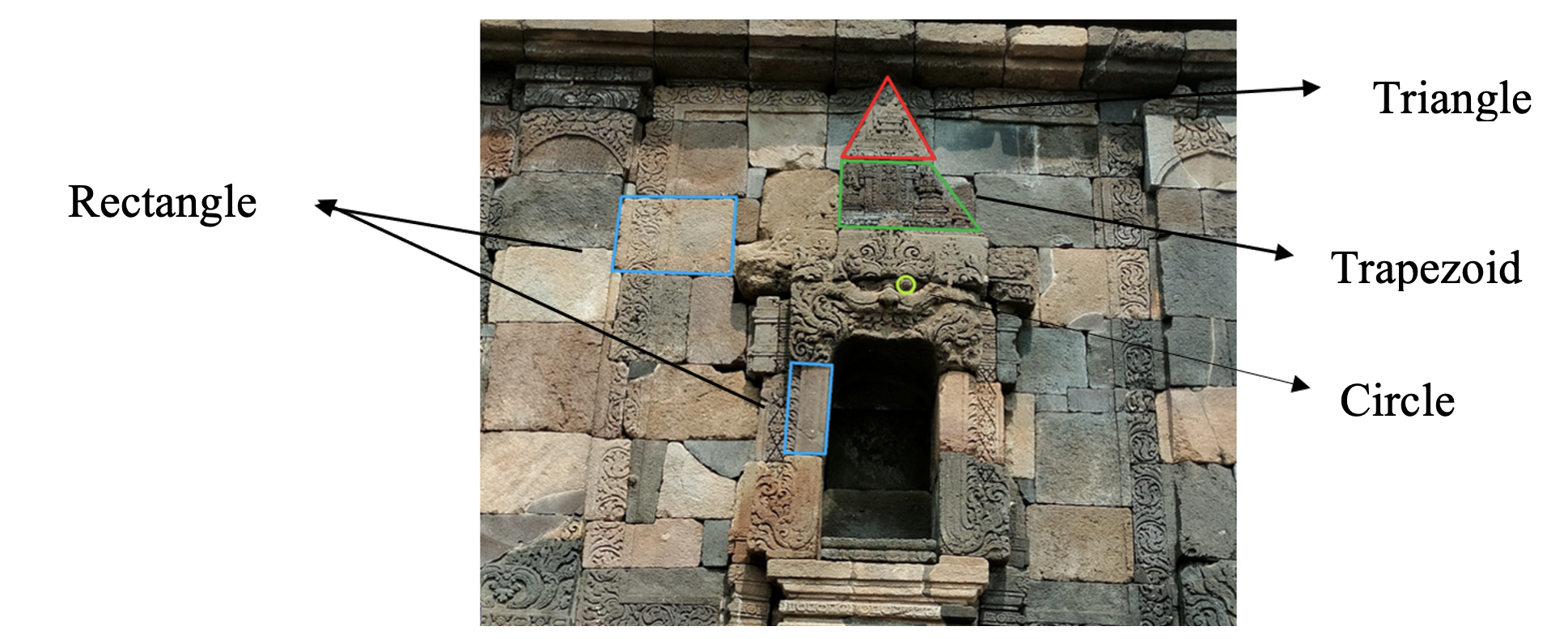The Geometry of Ijo Temple: Bridging Cultural Heritage and Mathematical Learning through Ethnomathematics
DOI:
https://doi.org/10.23917/varidika.v36i2.7143Keywords:
Ethnography, Ethnomathematics, Education, Mathematics, CultureAbstract
Ethnomathematics examines the relationship between mathematics and cultural practices, highlighting mathematical concepts embedded within diverse cultural contexts. Ijo Temple, located approximately 4 km southeast of Ratu Boko Temple and 18 km east of Yogyakarta, stands as a prominent cultural site in Indonesia. While prior studies have explored mathematical elements within cultural heritage, limited attention has been given to the geometric concepts inherent in Ijo Temple's architecture. This study bridges this gap by analyzing the temple's architectural geometry through an ethnographic lens, guided by four key research questions: “Where do I observe?”, “How do I investigate?”, “How do I identify significant findings?”, and “How do I interpret these findings?”. The investigation uncovers various geometric sub-concepts, validated in collaboration with geometry experts. These include (1) planar geometry, encompassing triangles, rectangles, squares, trapezoids, and circles; (2) spatial geometry, such as cubes, rectangular prisms, and cylinders; (3) geometric transformations, including translation, reflection, and dilation; and (4) congruence principles. Beyond contributing to the academic discourse on geometric applications within cultural heritage, this research underscores the potential of culturally contextualized learning to enhance students' mathematical understanding.
Downloads
References
Alexander F. Mironychev. (2018). SAS and SSA Conditions for Congruent Triangles. Journal of Mathematics and System Science, 8(2). https://doi.org/10.17265/2159-5291/2018.02.003
Anh, T. H., & Hung, T. X. (2020). Shadow Map Construction using 2D Homography. International Journal of Engineering and Advanced Technology, 9(4), 2485–2488. https://doi.org/10.35940/ijeat.D6480.049420
Arsyad, A. (2014). Media Pembelajaran. PT. Raja Grafindo Persada.
Ascher, M. (1991). Ethnomathematics: A Multicultural View of Mathematical Ideas. https://doi.org/10.1201/9780203756522
Barkah, M. A., & Agustina, R. (2020). Pemanfaatan Augmented Reality (Ar) Sebagai Media Pembelajaran Interaktif Pengenalan Candi-Candi Di Malang Raya Berbasis Mobile Android. Bimasakti, 1(5), 1–6.
Budiarto, M. T., Artiono, R., & Setianingsih, R. (2019). Ethnomathematics: Formal Mathematics Milestones for Primary Education. Journal of Physics: Conference Series, 1387(1), 012139. https://doi.org/10.1088/1742-6596/1387/1/012139
Delman, C. I., & Galperin, G. (2003). A Tale of Three Circles. Mathematics Magazine, 76(1), 15–32. https://doi.org/10.1080/0025570X.2003.11953942
Djannah, M., Ishartono, N., Hayuni, A. A., Mufidah, A., Firdaus Bin Sufahani, S., & Waluyo, M. (2024). Exploring Ethnomathematical Geometry in Indonesian Shadow Puppetry Gunungan: Philosophical and Educational Implications. Jurnal Varidika, 36(1), 110–125. https://doi.org/10.23917/varidika.v36i1.5661
Ebbers-Baumann, A., Grüne, A., & Klein, R. (2007). Geometric dilation of closed planar curves: New lower bounds. Computational Geometry, 37(3), 188–208. https://doi.org/10.1016/j.comgeo.2004.12.009
Gjurchinovski, A., & Skeparovski, A. (2008). Einstein’s Mirror. The Physics Teacher, 46(7), 416–418. https://doi.org/10.1119/1.2981289
Hadi, W., & Widyaningsih, H. (2021). Persepsi Wisatawan Dengan Sapta Pesona Di Candi Ijo Desa Sambirejo, Prambanan, Sleman. Khasanah Ilmu - Jurnal Pariwisata Dan Budaya, 12(1), 39–48. https://doi.org/10.31294/khi.v12i1.10140
Hardiarti, S. (2017). Etnomatematika: Aplikasi Bangun Datar Segiempat pada Candi Muaro Jambi. AKSIOMA, 8(2), 99. https://doi.org/10.26877/aks.v8i2.1707
Irsyad, M., Sujadi, A. A., & Setiana, D. S. (2020). Eksplorasi Etnomatematika pada Candi Asu. UNION: Jurnal Ilmiah Pendidikan Matematika, 8(1), 11–19. https://doi.org/10.30738/union.v8i1.7609
Ishartono, N., & Ningtyas, D. A. (2021). Exploring Mathematical Concepts in Batik Sidoluhur Solo. International Journal on Emerging Mathematics Education, 5(2), 151. https://doi.org/10.12928/ijeme.v5i2.20660
Jayanti, T. D., & Puspasari, R. (2020). Eksplorasi etnomatematika pada Candi Sanggrahan Tulungagung. JP2M (Jurnal Pendidikan Dan Pembelajaran Matematika), 6(2), 53. https://doi.org/10.29100/jp2m.v6i2.1748
Kwinta, A., & Gniadek, J. (2017). The description of parcel geometry and its application in terms of land consolidation planning. Computers and Electronics in Agriculture, 136, 117–124. https://doi.org/10.1016/j.compag.2017.03.006
Majerek, D. (2014). Application of Geogebra for Teaching Mathematics. Advances in Science and Technology Research Journal, 8, 51–54. https://doi.org/10.12913/22998624/567
Martin, G. E. (1982). Transformation Geometry: An Introduction to Symmetry. Springer-Verlag New York. https://doi.org/10.1007/978-1-4612-5680-9
Maryati, & Prahmana, R. C. I. (2019). Ethnomathematics: Exploring the activities of culture festival. Journal of Physics: Conference Series, 1188, 012024. https://doi.org/10.1088/1742-6596/1188/1/012024
Masruroh. (2019). Peningkatan Perkembangan Kognitif Melalui Permainan Balok Geometri Pada Anak Usia 3-4 Tahun Di PPT Mawar 01 Ar-Rachman Surabaya. MOTORIC, 3(2), 55–64. https://doi.org/10.31090/m.v3i2.892
Mulbasari, A. S., Putri, R. I. I., Zulkardi, & Aisyah, N. (2024). Validity of PMRI-Based Geometry Teaching Materials for Elementary School Students. Indiktika: Jurnal Inovasi Pendidikan Matematika, 6(2), 339–347. https://doi.org/10.31851/indiktika.v6i2.15143
Prahmana, R. C. I., & Ubiratan, D. (2020). Learning Geometry and Values from Patterns: Ethnomathematics on The Batik Patterns of Yogyakarta, Indonesia. Journal on Mathematics Education, 11(3), 439–456. https://doi.org/https://doi.org/10.22342/jme.11.3.12949.439-456
Repiyan, S. M., Machromah, I. U., Faiziyah, N., & Ishartono, N. (2023). Ethnomathematics: Mathematical concepts in Yogyakarta’s typical hand-drawn Batik. AIP Conference Proceedings, 020021. https://doi.org/10.1063/5.0141606
Risdiyanti, I., & Indra Prahmana, R. C. (2017). Ethnomathematics: Exploration in Javanese culture. Journal of Physics: Conference Series, 943, 012032. https://doi.org/10.1088/1742-6596/943/1/012032
Sutama. (2019). Metode Penelitian Matematika. Jasmine.
Vitoria, L., & Monawati. (2020). Developing ethnomathematics-based worksheet to teach linear equations. Journal of Physics: Conference Series, 1460(1). https://doi.org/10.1088/1742-6596/1460/1/012021
Vitoria, L., Monawati, M., Fauzi, F., & Mislinawati, M. (2021). Assessing the Effect of an Ethnomathematics Teaching Material on Students’ Understanding of Mathematics. JPP (Jurnal Pendidikan dan Pembelajaran), 28(1), 10–16. https://doi.org/10.17977/um047v27i12021p010
Wardhani, S., & Rumiati. (2011). Instrumen Penilaian Hasil Belajar Matematika SMP: Belajar dari PISA dan TIMSS. In Yogyakarta: Pusat Pengembangan dan Pemberdayaan Pendidik dan Tenaga Kependidikan (PPPPTK) Matematika.
Witanto, Y. (2019). Learning The Concept of Cube Using Cabri 3D V2. Proceedings of the International Conference Primary Education Research Pivotal Literature and Research UNNES 2018 (IC PEOPLE UNNES 2018). https://doi.org/10.2991/icpeopleunnes-18.2019.31

Downloads
Submitted
Accepted
Published
Versions
- 01/17/2025 (2)
- 12/23/2024 (1)
Issue
Section
License
Copyright (c) 2024 Olly Orva Peggy Kim Carla, Naufal Ishartono

This work is licensed under a Creative Commons Attribution 4.0 International License.












